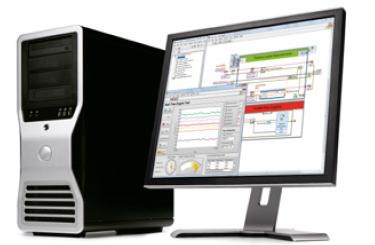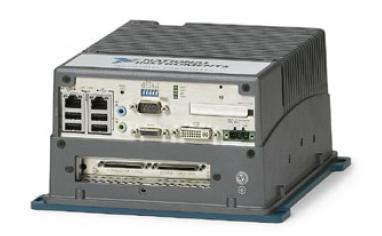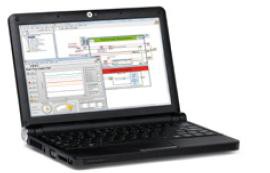How to Choose the Right Computer for Your Measurement System
Overview
6 Questions to Ask Yourself When Choosing the Right Computer
Additional Information
1. How much processing power do I need?
Nearly every computer has three main components that affect data management capabilities: the processor, the RAM, and the hard drive. The processor is the part of the computer that interprets and executes instructions — think of it as the brain of the computer. Processors in most new computers are either dual- or quad-core, meaning the computer can use two or more independent actual processors (called "cores") to read and execute program instructions. The processing power for a computer also consists of the RAM, the hard drive size, and the processor speed. More RAM improves speed and enables more applications to run at the same time. More hard drive space gives you the ability to store more data. Finally, faster processors enable faster operation of your application. In general, faster is better, but processor speeds across brands may not be the same. If you need to analyze or save the data you acquired from your application, processing power is a key feature to consider for your computer.
2. Do I need my computer to be portable?
Portability is a key feature to consider for your computer if you are going back and forth between applications or locations frequently. For example, a portable computer is essential for taking measurements in the field and then returning to the lab to analyze the data. Portability is also an important feature if you need to monitor applications in different locations. The key considerations when assessing portability are the product size and weight. You wouldn’t want to carry around a heavy computer that is difficult to hold.
3. How much does the computer cost?
Budget is a concern for nearly every project, and more than likely your computer makes up a large portion of the total system cost. Features and form factor contribute the most to overall cost. Choosing a computer for your application becomes a trade-off between price and performance; better features cost more and drive up the price. For example, a computer with a faster processor is more expensive. Additionally, form factor makes a difference in the cost of the computer. Typically, between a laptop and a desktop with similar features, a laptop is more expensive due to the added portability. Finally, industrial specifications or optimizations for instrumentation may increase system cost with the added benefit of providing a rugged test platform.
4. How rugged do I need the computer to be?
The ruggedness of your computer can be a crucial feature if you are monitoring your application in an extreme environment. The specifications of a computer that refer to ruggedness are the operating conditions. Standard off-the-shelf PCs are not designed to withstand the conditions of industrial environments. For example, the operating conditions for computers consist of operating and storage temperature, relative humidity, and maximum operating and storage altitude. Typical specifications are 50 °F to 95 °F (operating temperature), -13 °F to 113° F (storage temperature), 10,000 feet (operating altitude), and 15,000 feet (storage altitude); therefore, any computers featuring specifications greater than these are considered rugged. You need to pay attention to this feature only if your application requires it.
5. Do I need my computer to be modular?
The modularity of your computer can be crucial if you are considering future applications or are working on multiple applications. Modularity describes the degree to which a system’s components may be separated and recombined. If you want to switch modules in your system or modify your applications easily, having a modular system is crucial. The flexibility you can achieve with a modular computer is unmatched. You can modify and adapt the system to meet your particular needs and expand for the future as well as upgrade individual components without having to buy a whole new system. With a modular system, you can install a new hard drive if you need more space or use a data acquisition device with a faster analog-to-digital converter if you need faster sampling. Keep in mind that laptops and netbooks provide portability, but they are more integrated, which makes them harder to upgrade. Modularity can be an important feature if you need to adapt your current application to future needs.
6. Do I need a real-time operating system?
The operating system is an important feature to consider when choosing a computer for data acquisition. By far the most common general-purpose operating system is Windows, but data acquisition and control applications occasionally require a more specialized operating system. A real-time operating system gives you the ability to operate deterministically, meaning applications can execute according to precise timing requirements. A real-time operating system is deterministic because the operating system does not determine which process happens when; rather, the user defines the order and timing of the processes. This gives you more control over your application and the ability to execute at faster rates than with a nondeterministic operating system. If you need a computer with a deterministic operating system, then you want to look for computers that meet those requirements.
Learn more about a real-time operating system
Computer Selection Guide
Based on the six questions previously examined, Table 1 shows a selection guide for the most common types of computers.
| PXI System | Desktop | Industrial PC | Laptop | Netbook |
Processing Power | Best | Best | Better | Better | Good |
OS Compatibility | Best | Best | Good | Better | Good |
Modularity | Best | Better | Better | Good | Good |
Ruggedness | Better | Better | Best | Good | Good |
Portability | Better | Good | Good | Best | Best |
Cost | Good | Better | Good | Better | Best |
Table 1. This table shows a computer selection guide based on the six most important features.
Overview of Computer Types
Five different types of computers are typically used for data acquisition. The computer communicates with your data acquisition hardware; therefore, which computer you choose depends on your data analysis needs, the environment that the system operates in, and the channel count needed for your system. This section focuses on the following types of computers:
- PXI system
- Desktop
- Industrial PC
- Laptop
- Netbook
PXI System
Figure 1. A PXI system contains a controller, chassis, and up to 17 modular instruments.
PXI (PCI eXtensions for Instrumentation) is a modular, rugged, PC-based platform for measurement and automation systems. A PXI system consists of a controller, chassis, and instrumentation modules. The PXI system controller runs the operating system and serves as the “computer” for the system; it contains a processor, RAM, hard drive, and so on. The chassis houses the controller and contains anywhere from 4 to 18 slots, which you can use to combine your computer and instrumentation into a single, compact package. If your application incorporates a variety of measurements and requires tight synchronization between instruments, or if your instrumentation needs to adapt to applications in the future, your best solution may be PXI. PXI is a powerful, flexible instrumentation platform; however, the modularity of a PXI system may involve a higher initial cost than a laptop or desktop with USB instrumentation. That being said, choosing a PXI system upfront could save time and money in the future as your instrumentation needs change.
Desktop
Figure 2. Desktop computers often include the latest PC technology at a reasonable price.
A desktop computer is a PC intended for regular use at a single location. Desktop computers are typically used in offices, labs, or anywhere that is not an extremely harsh environment. These computers consist of a few parts: a monitor, a keyboard, a mouse, and the computer itself. Since there are so many parts to a desktop computer, you do not want to repeatedly move it to different locations. However, because desktop computers are larger, they can dissipate more heat, allowing them to house larger, more powerful processors. Therefore, the biggest attribute of the desktop computer is the processing power. If you need to analyze data or log data to disk at fast rates, but you don’t require mobility, the desktop computer may be exactly what you need for your application.
Industrial PC
Figure 3. Industrial computers feature all of the components of a standard PC with a rugged mechanical design.
Industrial PCs, as the name suggests, are special computers optimized for use in industrial or harsh environments. Industrial PCs are mechanically stronger and environmentally rated for extreme vibration, shock, temperature, and humidity. However, due to their robust design, these PCs are more expensive than other types of computers. These ratings are essential for many applications, so if you need to monitor applications in harsh environments, the industrial PC is a great choice for your application.
Laptop
Figure 4. You can use lightweight, portable laptop computers to acquire data in the field.
A laptop computer is a PC intended for mobile use. Because of their size, laptops are typically used with portable measurement systems. All of the parts are housed together in one laptop, making it very easy to move it from place to place. A laptop gives you the freedom to monitor different applications at multiple locations with ease. But since all of the parts are together in one unit, you need to make sure the environment you expose the laptop to is not going to damage it. For instance, most laptops may not be rated for dust or moisture. If you are looking for a portable, general-purpose computer with the ability to analyze and store data, a laptop computer may meet your needs.
Netbook
Figure 5. Netbooks sacrifice processing power, but offer lower cost and smaller size.
A netbook computer is a PC intended for mobile use, much like laptop computers. Netbooks are extremely small in size and low cost due to lower cost components and lower power processors. With netbooks, you sacrifice processing ability and ports for connecting peripheral devices, but in the end you have an extremely portable computer for a fraction of the price of more powerful options. The netbook presents a trade-off between cost, size, and performance. It is ideal for your application if you need a low-cost, portable computer for data acquisition that can also perform minor analysis.
Next Steps
Download the complete guide to building a DAQ system
Review the advantages of choosing NI DAQ for your application




